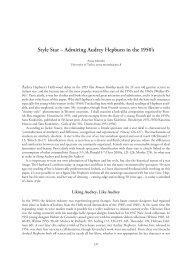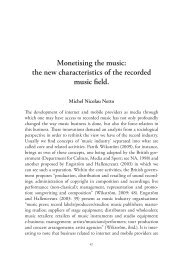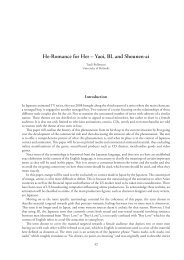Fans, Fawns and Fauns: Ballet Stardom, Dancing Genius and ... - IIPC
Fans, Fawns and Fauns: Ballet Stardom, Dancing Genius and ... - IIPC
Fans, Fawns and Fauns: Ballet Stardom, Dancing Genius and ... - IIPC
You also want an ePaper? Increase the reach of your titles
YUMPU automatically turns print PDFs into web optimized ePapers that Google loves.
In the academic queering of Nijinsky, however, his life is edited to fit not the narrative of genius but that of<br />
queer imperfection <strong>and</strong> tragedy. In writing of Nijinsky, authors from Richard Buckle (1993, esp. 173-174) to<br />
Kevin Kopelson (1997, 48, 90, 144-145) have chosen to believe hearsay about hearsay to “confirm” that, for example,<br />
Nijinsky’s dance technique was never “pure”, that his dancing was, itself, awkwardly queer, <strong>and</strong> that he was<br />
never good at partnering women on stage or off. His marriage <strong>and</strong> his choreographic work, particularly his last<br />
ballet, Till Eulenspiegel (of 1916), are repeatedly represented as indicating his madness, his perverse desire to leave<br />
Diaghilev <strong>and</strong> get married to a woman, whom he would not be able to partner as he had partnered Diaghilev. In<br />
this way, Nijinsky’s insanity is in his heterosexuality, but his self is still identified with the roles he danced.<br />
Thus, paradoxically, at a time when Nijinsky’s reputation as a choreographer of genius has been resurrected in<br />
the ‘straight’ hegemonic discourse, the queer academic discourse perpetuates the old backlash against Nijinsky’s<br />
popularity <strong>and</strong> against Nijinsky as a popular icon. Is this, I wonder, because defining human beings through their<br />
sexual behaviour is so very nineteenth-century that it automatically produces nostalgic fantasies? Or is it because<br />
the queer afterlife of Nijinsky is slightly too popular <strong>and</strong> too camp to support the status of aspiring academic<br />
experts? Perhaps we ought to take the faun by the horns <strong>and</strong> demolish the artificial cultural division into ‘high’<br />
<strong>and</strong> ‘low’, ‘art’ <strong>and</strong> ‘entertainment’, construed through notions like ‘genius’. By discussing the similarities of the<br />
reception of different kinds of stars we might actually explain something of their allure <strong>and</strong> of ourselves as their<br />
audiences.<br />
Notes<br />
1 Nijinsky’s <strong>and</strong> Diaghilev’s relationship was not stated out loud in contemporary sources, since (male) homosexuality was criminal in<br />
most European countries, including Russia. However, the Russian law was never enforced very strictly, thanks to cultural reasons<br />
having to do with the rule of aristocracy <strong>and</strong> the association of ‘sexuality’ (i.e. the idea that sexual acts fundamentally constituted<br />
the identity of an individual) with Western political liberalism <strong>and</strong> cultural decadence. See Healey 2001; Engelstein 1992, passim.<br />
esp. 56-95, 99, 132, 223-229; also Spector 1969, 205-206; <strong>and</strong> Karlinsky 1989, 347-351.<br />
2 E.g. Laloy in La Gr<strong>and</strong>e revue 10.6.1909: “il est virginal. Ici c’est une beauté sans attirance; c’est la beauté de l’homme, dont les<br />
femmes ne sont, pour l’ordinaire, ni capables, ni ambitieuses. L’art s’accorde avec la morale pour l’estimer la plus élevée.” Similarly,<br />
Henri Ghéon wrote of Isadora Duncan in La Nouvelle revue française, March 1911 as a natural spectacle that did not merit being<br />
called art.<br />
3 “No doubt the image is daring, perhaps answering [our] underst<strong>and</strong>ing of the fauns of Antiquity, but no doubt it is pornographic<br />
only to the lustful imagination, in contrast to Nijinsky’s naive, honest depiction of something that 99 out of a hundred young<br />
men has got himself acquainted with.” Minsky in Utro Rossii 24.5./6.6.1912. Similarly, Anatoly Lunacharsky in Teatr i iskusstvo<br />
15.6./28.6.1912.<br />
4 E.g. Lunacharsky Teatr i iskusstvo 9./22.6.1913; Minsky in Utro Rossii 30.5./12.6.1913; Volkonsky in Apollon 6/1913; Levinson in<br />
Rech 3./16.6.1913; Karatygin in Rech 16.2./1.3.1914.<br />
5 See e.g. Miller 1995, 208-213; Karlinsky 1989. The Wilde-Douglas analogy is common, found e.g. in Kopelson 1997, 4-5, <strong>and</strong> has<br />
led people to think of Diaghilev as the creative genius <strong>and</strong> Nijinsky as his tormentor (itself a stereotype unjust to both Wilde <strong>and</strong><br />
Douglas). For more lurid speculation about the sex-lives of Nijinsky <strong>and</strong> Diaghilev, see e.g. Batson 1997, 187-188; Kopelson 1997,<br />
passim., e.g. 9,17.<br />
6 The discussion on the aesthetics of the <strong>Ballet</strong>s Russes, particularly the section on Nijinsky’s modernism (Garafola 1992, 50-75) is<br />
definitely the weak point in Garafola’s book. Similarly, Hanna 1988, 184-185 conflates Nijinsky with the Western interpretation<br />
of his choreographies; both are probably following Kirstein 1971, 199 in claiming Nijinsky’s choreographies his erotic autobiography.<br />
As noted, the Russians interpreted these works very differently, <strong>and</strong> Nijinsky himself seems to have been somewhat baffled<br />
by the Western reviews as well: see his interviews in L’Intransigeant 13.6.1912; Je Sais Tout, November 1912; <strong>and</strong> Pall Mall Gazette<br />
15.2.1913. He even returned to the matter in his so-called Diary, written in 1919 (Nijinsky 1999, 203, also 204, 207). Although<br />
authorial intention is always a little suspect, Nijinsky’s persistence indicates he thought it important to correct the public’s misconception<br />
of his work.<br />
7 Studlar 1995 sees Nijinsky’s ghost in Douglas Fairbanks’s role for The Thief of Bagdad (1924); Moon 1995 in Jack Smith’s film Flaming<br />
Creatures (1963); <strong>and</strong> Franklin 2001 discusses how Charlie Chaplin may have imitated Nijinsky.<br />
Works cited<br />
Archival materials:<br />
The New York Public Library Dance Collection at Lincoln Center<br />
NYPLDC Astruc Papers. Papers by Gabriel Astruc (1864-1938), the French impresario of the <strong>Ballet</strong>s Russes.<br />
NYPLDC Nijinsky Clippings. Press cuttings (7 folders) concerning the career of Vaslav Nijinsky (1889-1950).<br />
Batson, Charles Richard. Words into Flesh: Parisian Dance Theater, 1911-1924. PhD thesis, University of Illinois at Urbana-Champaign, 1997.<br />
122







